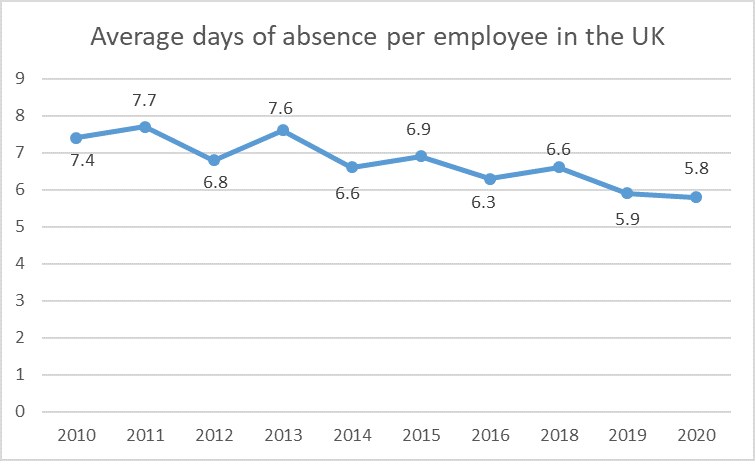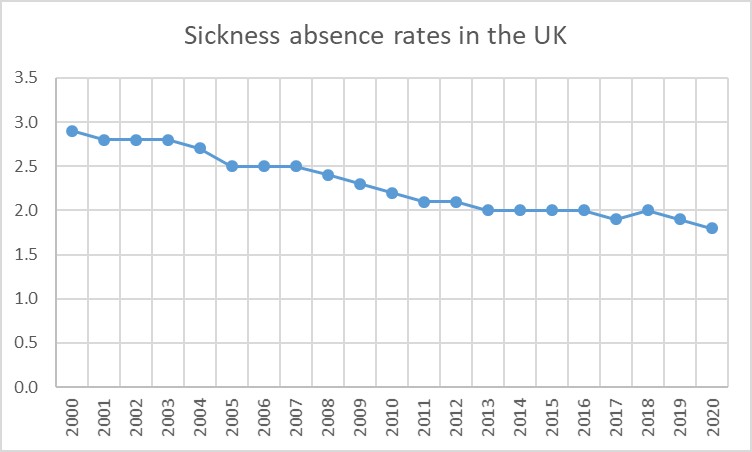Did you know that 57% of all absences from work are due to stress, anxiety, and depression? And these mental health problems cost £2.4 billion to UK employers per year. Also, 38.8 million working days were lost due to work-related ill health and non-fatal workplace injuries in 2019-2020. These statistics suggest how severe the condition of absenteeism in the workplace really is. Also, allowing high absenteeism in the workplace can be bad for business.
Keeping the absenteeism rate low is very crucial for an efficient Human Resource Management system.
Table on Contents
What is absenteeism?
Absenteeism is referred to a habitual pattern of absence from work without any good reason. It can also be defined as absence from work for lengths of time beyond what is viewed as an acceptable time. Because it can cause significant problems for a business. On the other hand, presenteeism is when employees are at work, but they aren’t actually working.
The cost of absenteeism for a business is really high. It impacts the workload of others and makes it harder to achieve goals. Most importantly, it has a negative impact on the company’s bottom line.

Absenteeism can be divided into the two types below –
Planned absenteeism
Planned absenteeism refers to absences from work such as scheduled time off, retirement, and sabbaticals. It is important to note that absenteeism in the workplace does not include excused absences as the employer has already granted the employee permission to miss work. Also, these types of absences cause little to no disruption in the workspaces. That is because they are planned out and given time to work around the absence.
Planned absenteeism includes annual leave, paid time off, holidays, staff development leave, or planned medical treatment leave, etc.
Unplanned absenteeism
Generally, absenteeism is referred to unplanned absences. Unplanned absenteeism from work is referred to absence that is not planned or predictable. For example, sick time off, injured time off, special circumstances, and absence without permission.
Unplanned absenteeism includes emergencies and short-term absences related to stress, illness, injury, or personal issues. Unplanned absences indicate a critical factor in the health of the workplace, including employee satisfaction and commitment.

How to measure absenteeism in the workplace?
The formula to measure absenteeism is straightforward. Take the number of absent days over a specific time period, divide it by that total period. And then multiply that new number by 100. This will give you the absenteeism percentage for that time period.
The formula looks like this:
(Number of days of unexcused absences/total period) x 100 = % of Absenteeism
Here, unexcused absences are referred to as unplanned absenteeism.
What is the average absence rate in the UK?
According to Statista, the average level of absence in the UK was 5.8 days per employee in 2020.

Source: Statista (Days of absence per employee in the UK 2010-2019)
What are the major causes of absenteeism in the workplace?
Employee absenteeism in the workplace can have a significant impact on your company’s bottom line. Along with revenue, employee absenteeism can negatively affect morale and productivity. A team can not perform its best without all its members present. Also, other employees might feel burdened by the extra work they need to take on.
Hence, it’s critical to determine the root causes and attempt to mitigate employees’ absences. Otherwise, it could be detrimental to your workplace culture and your company’s long-term success.
There are several reasons why people miss work, which may include both personal issues and work-related issues. These usually fall into the categories below:
1. Mental health issues
Almost 57% of all absences are attributed to anxiety, depression, and social anxiety. This means mental health issues are becoming more challenging with time.
According to the Mental Health Foundation, this accounts for as many as 70 million lost workdays each year. Unfortunately, most businesses can’t afford to lose this much.
The recent coronavirus outbreak has substantially worsened the problem, leading more employees than ever to call in sick. The causes for absenteeism range from anxiety-related issues to contracting the virus or deteriorating mental health problems.
2. Lack of a flexible work schedule
Flexible working hours are a necessity rather than a privilege. Employees have their own social commitments and personal responsibilities to follow through. That is why employees need a sound work-life balance.
The below-mentioned personal responsibilities are common reasons for absence from work.
- Lack of childcare
- Taking care of a dependant (a person who relies on the employee)
- Dentists’ appointments
- Hospital appointments
HR Magazine says that almost 80% of women with children between the ages of 6 and 13 work outside the home. So whenever a child is ill or regular childcare arrangements fall through, one of the parents may have to take leave to look after their child.
In such cases, the lack of a flexible working schedule can cause the employee to miss out on work to follow up on their personal responsibilities.
3. Workplace harassment
A report says that 1 out of 4 UK employees are bullied at work. At the same time, 25% of employees feel left out in the workplace. Such issues with other employees in the workplace are one of the most common causes of absence from work.
For example, making verbal comments that are intended to intimidate, offend, humiliate or degrade a person is bullying. However, it can be hard to detect unless the employee reports the problem.

4. Low employee engagement
Employee engagement is a vital part of work culture. In short, it is the practice followed by companies to bring employees closer to their workplace.
Employees who feel a connection to their workplace are more likely to perform better than those who don’t. Having low or no employee engagement at work is one of the main reasons behind employees’ unscheduled absences. With low employee engagement, your company will have low productivity, poor work quality, and high absence rates.
5. Illness & physical injuries
Absence due to illness or injury is to be expected. Also, it’s understandable that employees need time off work to recover. However, difficulties arise when the employee in question doesn’t let their employers know. That leaves the employer unable to provide the cover they need to continue business as usual.

Source: Office for National Statistics – Labour Force Survey
Here the sickness absence rate is the percentage of working hours that are lost due to sickness absence. The lowest sickness absence rate was recorded in 2020, with only 1.8%.
6. Low morale
Low morale has a direct association with high absenteeism. Tensions and conflict in the workplace often arise. That causes stress and places an additional burden on the employees. Suppose these employees don’t respect the management team or aren’t respected or given any autonomy. In that case, they may suffer from low morale.
Stressed workers experience an overall reduced sense of wellbeing leading to low morale. Here are 10 Ways to Eliminate Stress in the Workplace to make way for an effective work environment.
7. Job hunting
When an employee is looking for a new job elsewhere, they are more likely to take leave. Because they would be attending interviews at times that might clash with working hours.
Employees may call in sick, explaining that they have a stomach bug or the flu. The reality might be that they’re actually struggling with a personal problem or depression, or they just don’t want to be at work.
That’s why it’s important to remain proactive and ensure that steps are in place to help employees. That will help reduce absenteeism in the workplace.
What are the negative effects of absenteeism in the workplace?
Absenteeism in the workplace comes with a lot of negative consequences. Even with the lowest recorded average days of absence per employee in the UK in 2020, the cost is still high for businesses. Analysis by Deloitte found that poor mental health alone cost UK employers up to £45 billion each year.
However, it can be challenging to attribute a monetary value to all the results of absenteeism. But they still affect the profitability of a business.
Here are some instances:
1. Employee burnout
Absenteeism means increased workload and working overtime. This leads to employee burnout which takes a toll on their effectiveness.

2. Reduced employee productivity
Absenteeism has a significant impact on individual productivity. To illustrate, if an employee works less, they’re likely to be less productive. Due to this, the amount of money paid out to the workers also increases which effectively hampers the company’s bottom line.
3. Management frustration
With increased expenses and less output, management may show frustration about the situation. This can lead to conflict between employees and management, worsening the situation further, especially since less output reflects poorly on the management too.
4. Customer dissatisfaction
The lack of productivity and manpower inevitably affects the product or service. And after a bad experience, customers are less likely to come back. This poorly affects business reputation, leading to fewer sales.
The impact of absenteeism is more than just a monetary business cost. It is pivotal to reduce absenteeism for a productive workplace and a profitable business.
How to reduce absenteeism in the workplace?
While some causes of absenteeism can’t be helped, there are ways to reduce absenteeism in the workplace.
The following can help employers improve company morale and proactively reduce absence from work at the same time.
1. Create a clear attendance policy
An employee attendance policy refers to the documented set of rules designed to improve employee productivity and reduce absenteeism. It contains clear and consistent employer expectations regarding attendance. It is put in place to maximise and motivate employee attendance.

Furthermore, it should explain the following:
- How employees should report their absence.
- How it will be recorded.
- Disciplinary procedures and consequences.
- How repeated absences are to be handled.
Many organisations include it as part of an employment contract. Also, it can be used as a guideline. And therefore, employees should adhere to the rules outlined in it. Having a clear absence policy helps to eradicate any grey area surrounding taking days off.
What should an absence policy cover?
An absence policy should clarify exactly what’s expected from both the employer and employee if the employee needs to take time off work.
According to ACAS, an absence policy should include:
- How to report absences (including when and whom the employee should contact)
- When the employee needs to have a sick note
- When the return to work discussions will be held and with whom
- How to keep in touch and when
- How the employer keeps track of the absence
- If they have any set review or ‘trigger’ points
- Whether the employer provides an employee assistance programme (EAP)
- How much the employee is to be paid and for how long
However, some areas are covered by the law. For instance:
- Statutory sick pay (SSP)
- Sick notes or fit notes
- Time off to help dependants
While creating an attendance policy, these should be considered and incorporated accordingly.
2. Implement a wellness program
Health promotion and wellness programmes can take care of your employees’ mental and physical health. These won’t just help them stay fit and healthy; they’ll also feel that the company genuinely cares about their well-being. Thus, it will help foster greater company loyalty, improve productivity, and reduce absenteeism in the workplace.

Besides, wellness programs are designed to fit well with an employees’ regular work schedule. And with the rise of cloud technology, executing such corporate wellness programs has become easier than ever before.
Consider it an investment instead of an expense. Because in the long run, it’ll save you money by keeping employees healthy and productive. It is very important to realise that.
3. Keep employees motivated
Motivation is the desire to achieve a goal or a performance level. It is the fuel that makes employees go back to work every day, and without it, they become less productive. So consider how you can create a more positive working environment. Because that will make the office a much more enjoyable place to be, effectively reducing absenteeism.

As shown above, performance is a function of the interaction among an individual’s motivation, ability, and environment. That indicates how important motivation is for job performance.
Also, you need to know what incentives work for them to keep them motivated. For example, you can introduce a reward scheme for most attendance to increase their motivation.
4. Offer flexible working hours
Offering your employees flexible working hours will help them a lot, especially in a stressful work environment. It will also make them appreciate the job more, increasing their willingness to work. By doing so, you might be able to support working parents and those with other responsibilities. You can also offer them a remote working opportunity if that is feasible. By achieving a work-life balance, they can continue to bring their best to your business without making any sacrifices.

Overall, this will reduce stress, boost morale. It will also show others that your business is forward-thinking and can adapt to the needs of your employees.
5. Address attendance on employee’s performance evaluation
One-on-one performance review gives the employer an opportunity to address absenteeism issues. Offering them the opportunity to self-evaluate their productivity will prove to be beneficial. It will create a positive dialogue between the employee and the employer. Performance reviews and other types of employee meetings can resolve obstacles and lay the groundwork for decreased absenteeism in the future.
Providing feedback and showing appreciation can help improve absenteeism. But if their absenteeism rate is high, make sure to deliver criticism in a constructive way. You should also consider how you can provide further incentives to keep your team motivated.
6. Use robust absence management tools
Accurate absence records are very important for businesses. They help avoid conflicts at work and limits unscheduled absences.
They will provide you with a transparent and time-saving leave management process.
- actiPLANS
- TimeTac Leave Management
- Engage
- My HR Toolkit
- Staff2
- aCloud TeamSeer
- E-Days
Some shared features of these tools are as follows:
- Basic absence management features
- Time tracking
- Absence monitoring
- Reports and charts
- Tracking sick days
Based on this information, you can take a better approach to managing employee absenteeism. When the employees know that there is an efficient tool to track their activities, they will be less likely to slack off. This will provide easier tracking and documentation for employee leave management.
7. Employee engagement programs
Employee engagement programs help employers keep their employees hooked to their workplace. Such programs raise the standard of workplace operations by bridging the gap between employees and their employers. Moreover, it makes the employees feel privileged about being a part of the workplace with various activities and benefits.
They contain employee engagement activities. Employee engagement activities can be developed based on the employee needs and size of the workforce. Recognising employees’ efforts and appreciating them is also a viable way to reduce absenteeism in the workplace.
Some effective employee engagement activities are given below –
a) Build an effective ‘employee of the month’ program
Set up parameters, rules, and rewards. Also, you must decide on what basis will you select the employees. Lastly, celebrate the winner!

b) Provide feedback
Feedback is one of the most influential and overlooked weapons in your employee engagement activities arsenal. According to the Harvard Business Review, 57% of employees prefer corrective feedback to praise or recognition (only 43%). Indeed, helpful feedback is the key to improve workplace communication and engaging employees.
While giving feedback, remember to keep it constructive, relevant and private. Giving regular feedback is more effective. Also, remember that it’s a two-way street and don’t be harsh.
c) Hold TGIF meetings to engage the employees
TGIF (thank God it’s Friday) meetings help to keep everyone on the same page. An open Q&A session might also prove helpful. Complete transparency and consistency are key to its success.
d) Celebrate birthdays, anniversaries, and personal milestones
Your employees will be more likely to be engaged if they feel that their workplace is not without any soul or emotions. Every employee has their special days. Be sure to make those days more unique for your employees. It will give them a sense of belonging and make them feel cherished.
So make sure to sing the happy birthdays loudly!
e) Build an excellent mentorship program
A mentorship program is exceptionally vital for new employees, especially so that they aren’t left on their own to figure out how to do everything. A mentorship program is beneficial to both the receiving ends. Here, the mentor is a more experienced person who guides and advises a less experienced one.
There are many more employee engagement activities that can help motivate employees to go to work.
8. Compensation and benefits
Remuneration or compensation is an important part of HR Management. Compensation refers to all forms of financial returns and tangible benefits employees receive as part of an employment relationship. Employee compensation and benefits policy can make a huge difference in reducing employee absenteeism.
You can see a breakdown of the total returns from a job in the picture below.

Source: Compensation by George T. Milkovich, Jerry Newman
A good compensation package can reduce turnover, boost staff performance and increase employee productivity. If you want a healthy bottom line, you’ll need a happy, engaged, and productive staff. As compensation is the primary reason they work for you, it’s wise to start with it.
Depending on your capability and availability of funds, you should design the perfect compensation package for your employees. Find the perfect balance between their needs, wants, and your available resources. It would also be wise to have a decent compensation policy to guide your decisions regarding benefits and remuneration.
All of these helps reduce absenteeism in the workplace. The effectiveness of a chosen strategy usually depends on how suitable that particular tactic is for that work environment.
Some FAQs regarding absenteeism
Some additional information that might be helpful to you. For further information regarding Absenteeism, we suggest this course on HR Management.
1. How do you talk to an employee about excessive absenteeism? Or what to say to an employee who is always late?
Firstly, you can let them know you’ve noticed they’ve been regularly late to work/absent. And then ask them as to why they’ve been consistently late or absent. It’s possible they have a valid reason, such as caring for a child who is sick. It is very important to show empathy while being rational.
2. How many unexcused absences are acceptable before an employee is disciplined?
Excessive absenteeism can be defined as two or more occurrences of unexcused absence in a 30-day period. But it can vary depending on the company policy or relevant laws in that industry.
However, in general, two weeks or a total of 14 days per year is acceptable for missing work. However, they must be planned with excuses.
3. Can you terminate an employee for excessive absenteeism?
Generally, if an employee isn’t meeting the employer’s standards, then yes. If an employee has an excessive amount of absences, the employer may terminate their employment. Before you decide to let them go, make sure to comply with your absence policy and employment laws in place. Because unfair termination can also cost you a lot.
ACAS says the employer may consider formal action if the employee:
- Keeps taking sick leave or being late regularly
- Has unauthorised absences
- Seems as if they’re having trouble doing their job
Whether you can terminate an employee depends on two things — capability and conduct. You can also find fair reasons for the dismissal of an employee.
Word of caution for employees –
Unless you are secured by a union agreement or a specific contract, you have the risk that your employer may decide to replace you permanently if you miss too many days of work.
4. Can you fire someone for excessive sick days?
An employee can be dismissed if they have a persistent or long-term illness that makes it impossible for them to do their job.
But before taking any action, as an employer, you should:
- Look for ways to support the employee. For example, consider whether the job itself is making them sick and needs changing.
- Give them reasonable time to recover from the illness.
If the employee has any disability, the employer has a legal duty to support disability in the workplace. In such a case, dismissal because of a disability is unlawful discrimination.
5. How to deal with an employee who is always sick?
When an employee keeps calling in sick regularly, it can significantly impact a business’s productivity and, therefore, the bottom line.
You can follow the steps below to make sure you don’t do something unlawful (such as unfair dismissal) while protecting your business:
- Look for the early signs
- Be on top of the law
- Have a clear policy in place
- Work out what’s going on
- Ask for proof
- Ask for an independent examination
The bottom line
Employees are also humans. They may get sick and injure themselves. They need to rest and spend time with their loved ones. It is important to strike a work-life balance, so that absenteeism does not become an issue. Making sure that the employees are engaged in a healthy work environment is very crucial in that regard. Reducing absenteeism can be a long process, even with the right policies. HR must make it a point to support their employees and their aspirations within the workplace. Learn more about HR Management to ensure that problems like absenteeism don’t affect your business’ productivity, service standards, and employee wellbeing.







 May 24, 2021
May 24, 2021








